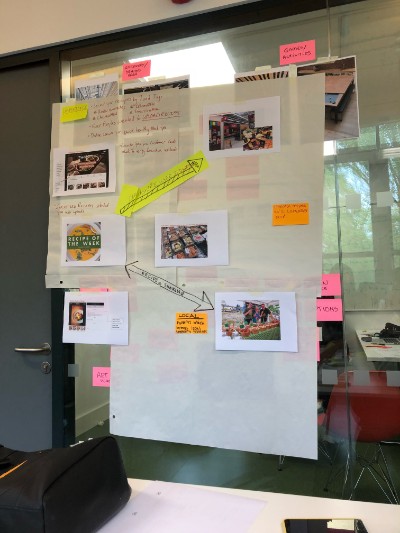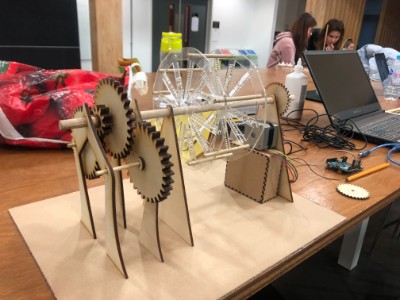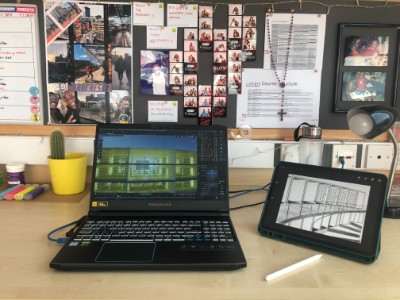As a third-year Design student at Lancaster University, I have been able to gain a lot of insight from my experience and generate useful reflections, so join me as I take a walk back in time.
The inside story of being a design student
by Tai Rosemin

My first year
Year one of studying Design centred around understanding the principles of design. My first-year modules such as Introduction to Design, explained the importance of design in everyday interactions.
Through interactive workshops we learnt about Don Norman’s Principles of Interaction Design for example, Affordances - if a door has a handle, you will be inclined to pull it, if it does not you will be inclined to push.
We also learned about Dieter Ram’s Principles for Good Design. By engaging in workshop activities that used soft prototyping to evaluate concepts or brainstorming and mind mapping to develop ideas, first year provided the fundamental groundwork to allow me to think and understand the world through design.

My second year
My second year of study focused on developing my practical skills. A broader approach to design was enlisted as second-year modules explored different applications of design. Modules such as Design Interactions explored the growing realm of design and technology.
In the second half of this module, we were able to explore User Experience and User Interface design (UX/UI) and we were tasked with understanding the student check-in experience, through the iLancaster app which we all redesigned and reinterpreted at the end of the module.
Materials was a very engaging module as we used technology in the form of coding and using 3D modelling software to render models and products that could be materialized in the workshop using the 3D printers and laser cutters. This module allowed us to push our creative boundaries and test the limits of our minds to create physical artefacts.
By contrast, other modules such as People, were grounded more in reality and exploring issues that affect society. In this module we were tasked with responding to the brief set by the Royal Society of Arts in the Student Design Award. We explored themes surrounding circular design and sustainable fashion, integration of design and technology to ensure happy, meaningful and productive lives and design making transport more accessible for the older generation.
My final year
Third year has obviously been different for me as now I am learning online due to COVID, but some of the modules I have taken this term have managed to be my favourite modules thus far.

Given that design is a collaborative process, my professors are using platforms such as Miro and Gather in addition to Microsoft Teams to allow us to collaborate and share ideas. In design workshops it is the norm for us to use sticky notes and use the whiteboard to communicate and express ourselves and having the ability to do that with current online learning has provided a seamless transition from the physical to the digital realm
One of the modules that I enjoyed this term was Design Studio: Contexts. For this module we were tasked with proposing and building a skyscraper that ‘should take into consideration the advances in technology, the exploration of sustainable systems, and the establishment of new urban and architectural methods to solve economic, social, and cultural problems of the contemporary city including the scarcity of natural resources and infrastructure and the exponential increase of inhabitants, pollution, economic division, and unplanned urban sprawl’ (Evolo.us).
For this module, I focused my project on looking at the air pollution that affects the people of Thailand. I love nature and the outdoors so it was rewarding to come up with a solution that can make clean air accessible for all.
Another first term module that stuck out to me was Advanced Design Interactions which explored designing interactive products and systems and examining how they can be applied in more specialised design areas such as smart cities and environments prime for emerging technology. It introduced us to the many sectors that exist at the crossroads of design and technology and allowed us to gauge for ourselves if this would be a field we could see ourselves in after graduating.
To conclude, studying Design at Lancaster University has been a very diverse experience, as diverse as the world we find ourselves in today. Design at Lancaster University does not specialize in one specific area but exposes us to different areas in our field to help give us a better understanding of the many ways in which our skills can be applied. Third year has indeed been different from the rest, but I do feel that the modules have been adapted to ensure the core aims are being conveyed. With a few more months to go, I am excited to see how my modules progress and how they evolve to suit the times.
_____
Tai is a third year undergraduate at Lancaster University and is studying Design.
Lancaster University employs students to create authentic content from a student perspective. All views expressed in this article are those of the students, and do not necessarily reflect the views or position of Lancaster University.
We update our courses regularly and sometimes the course details change - please visit our website for the most up to date information.

